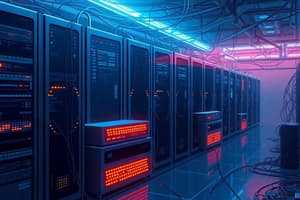Podcast
Questions and Answers
What is primarily required to establish communication between devices on a network?
What is primarily required to establish communication between devices on a network?
- A firewall
- Network protocols
- A central processing unit
- Transmission media (correct)
Which component is used to connect multiple networks together?
Which component is used to connect multiple networks together?
- Access Point
- Switch
- Hub
- Router (correct)
What must devices on a network use to be able to communicate effectively?
What must devices on a network use to be able to communicate effectively?
- Unique hardware components
- Different types of software
- Standardized network protocols (correct)
- Various internet connections
What is the role of a network interface in a device?
What is the role of a network interface in a device?
What term is used to describe the interconnected devices in a network?
What term is used to describe the interconnected devices in a network?
Which of the following is NOT a type of transmission media used in networks?
Which of the following is NOT a type of transmission media used in networks?
What is a central connection point in a large network typically referred to as?
What is a central connection point in a large network typically referred to as?
When configuring a network, what must each device have to send and receive data?
When configuring a network, what must each device have to send and receive data?
What is the purpose of a subnet mask in networking?
What is the purpose of a subnet mask in networking?
Which part of an IP address typically distinguishes individual devices on the same network?
Which part of an IP address typically distinguishes individual devices on the same network?
What indicates that an octet in a subnet mask is identifying the network portion?
What indicates that an octet in a subnet mask is identifying the network portion?
Why is it beneficial to consolidate storage on a file server within a network?
Why is it beneficial to consolidate storage on a file server within a network?
What is implied if devices can communicate easily within the same subnet?
What is implied if devices can communicate easily within the same subnet?
How can a network administrator manage user accounts effectively?
How can a network administrator manage user accounts effectively?
In a typical IPv4 address structure, what do the first three octets usually represent?
In a typical IPv4 address structure, what do the first three octets usually represent?
For devices on different subnets to communicate, what must occur?
For devices on different subnets to communicate, what must occur?
What is the significance of the octet value '0' in a subnet mask?
What is the significance of the octet value '0' in a subnet mask?
What does a network address consist of?
What does a network address consist of?
Which of the following is NOT a benefit of networking?
Which of the following is NOT a benefit of networking?
Why is it important for devices to have unique IP addresses?
Why is it important for devices to have unique IP addresses?
What role does the default gateway play in a network?
What role does the default gateway play in a network?
What is an octet in the context of an IPv4 address?
What is an octet in the context of an IPv4 address?
Flashcards are hidden until you start studying
Study Notes
Introduction to Networking
- Networks consist of interconnected devices (computers, tablets, phones, gaming consoles, IoT devices, and servers) that share information.
- Connecting to the internet joins the largest network globally, comprising various computers exchanging data.
Networking Components
- Key components needed to set up a network include:
- Network Nodes/Hosts: Various devices that connect and communicate.
- Transmission Media: Ways to connect devices such as twisted-pair cabling, fiber optics, or wireless signals.
- Network Interface: Converts digital data into signals usable on chosen transmission media; necessary for every device.
- Central Connection Point: Modern networks require devices to connect via switches or access points, with routers linking different networks.
- Network Protocols: Standards that define data formatting; essential for communication between devices.
Network Addressing
- Each device on a network has a unique identifier akin to house addresses in a neighborhood.
- Network Address Structure: Consists of a Network ID (like the street name) and a Host ID (like the building number), represented by an IP address.
- IPv4 Address Breakdown: Divided into octets (8 bits), separated by periods; the first octets usually indicate the Network ID, while the last indicates the Host ID.
- Subnet Mask: Defines which parts of the IP address identify the network and the host; critical for troubleshooting and traffic management.
- Values of 255 indicate network portions, while 0 indicates host portions in the subnet mask.
- Subnets: Smaller segments within larger networks; facilitates easier communication and routing through designated gateways.
Networking Benefits
- Resource Sharing: Centralizes resources like printers and file storage, reducing costs and enhancing efficiency via shared access.
- Consolidated Storage: Facilitates storage in centralized locations (file servers or NAS), easing data management and collaboration.
- Remote Collaboration: Tools like email and instant messaging enhance project-related communication across various locations.
- Efficient Management: Centralized management eases administration tasks, including remote data backup and security control.
- Operational Transformation: The ability to connect devices for resource sharing has significantly changed organizational dynamics, making knowledge of networking critical for technicians.
Summary
- Explored networking components, including transmission media, network interfaces, and protocols.
- Discussed network addressing fundamentals, specifically how IPv4 addresses are structured.
- Highlighted benefits like resource sharing, centralized administration, and collaboration enhancement.
Studying That Suits You
Use AI to generate personalized quizzes and flashcards to suit your learning preferences.




